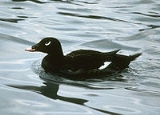
Scoter
Encyclopedia
The scoters are stocky seaducks in the genus
Melanitta. The drakes are mostly black and have swollen bills. Females are brown.
They breed in the far north of Europe
, Asia
and North America
, and winter
further south in temperate
zones of those continents. They form large flocks on suitable coastal waters. These are tightly packed, and the birds tend to take off together.
Their lined nests are built on the ground close to the sea, lakes or rivers, in woodland or tundra. These species dive for crustaceans and molluscs.
There are five species, grouped into two subgenera:
The presumed fossil
"scoter" Melanitta ceruttii which lived in California
during the Late Pliocene
is now placed in the genus Histrionicus.
Genus
In biology, a genus is a low-level taxonomic rank used in the biological classification of living and fossil organisms, which is an example of definition by genus and differentia...
Melanitta. The drakes are mostly black and have swollen bills. Females are brown.
They breed in the far north of Europe
Europe
Europe is, by convention, one of the world's seven continents. Comprising the westernmost peninsula of Eurasia, Europe is generally 'divided' from Asia to its east by the watershed divides of the Ural and Caucasus Mountains, the Ural River, the Caspian and Black Seas, and the waterways connecting...
, Asia
Asia
Asia is the world's largest and most populous continent, located primarily in the eastern and northern hemispheres. It covers 8.7% of the Earth's total surface area and with approximately 3.879 billion people, it hosts 60% of the world's current human population...
and North America
North America
North America is a continent wholly within the Northern Hemisphere and almost wholly within the Western Hemisphere. It is also considered a northern subcontinent of the Americas...
, and winter
Bird migration
Bird migration is the regular seasonal journey undertaken by many species of birds. Bird movements include those made in response to changes in food availability, habitat or weather. Sometimes, journeys are not termed "true migration" because they are irregular or in only one direction...
further south in temperate
Temperate
In geography, temperate or tepid latitudes of the globe lie between the tropics and the polar circles. The changes in these regions between summer and winter are generally relatively moderate, rather than extreme hot or cold...
zones of those continents. They form large flocks on suitable coastal waters. These are tightly packed, and the birds tend to take off together.
Their lined nests are built on the ground close to the sea, lakes or rivers, in woodland or tundra. These species dive for crustaceans and molluscs.
There are five species, grouped into two subgenera:
- subgenus Oidemia (BlackBlack ScoterThe Black or American Scoter is a large sea duck, 43 to 49 centimeters in length. Together with the Common Scoter M. nigra, it forms the subgenus Oidemia; the two are sometimes considered conspecific, the Black Scoter then being referred to as M. nigra americana...
and Common ScoterCommon ScoterThe Common Scoter is a large sea duck, 43-54 cm in length, which breeds over the far north of Europe and Asia east to the Olenyok River. The American/E Siberian M. americana is sometimes considered a subspecies of M. nigra.It winters further south in temperate zones, on the coasts of Europe as...
s) - subgenus Melanitta (SurfSurf ScoterThe Surf Scoter is a large sea duck, which breeds in Canada and Alaska. It is placed in the subgenus Melanitta, along with the Velvet and White-winged Scoters, distinct from the subgenus Oidemia, Black and Common Scoters.It winters further south in temperate zones, on the coasts of the northern USA...
, VelvetVelvet ScoterThe Velvet Scoter , also called a Velvet Duck or whitewing , is a large sea duck, which breeds over the far north of Europe and Asia west of the Yenisey basin. A small, isolated population nests in eastern Turkey...
and White-winged ScoterWhite-winged ScoterThe White-winged Scoter is a large sea duck.-Description:It is characterised by its bulky shape and large bill. This is the largest species of scoter. Females range from 950-1950 grams and 48–56 cm , averaging 1180 grams and 52.3 cm . She is brown with pale head patches...
s)
The presumed fossil
Fossil
Fossils are the preserved remains or traces of animals , plants, and other organisms from the remote past...
"scoter" Melanitta ceruttii which lived in California
California
California is a state located on the West Coast of the United States. It is by far the most populous U.S. state, and the third-largest by land area...
during the Late Pliocene
Pliocene
The Pliocene Epoch is the period in the geologic timescale that extends from 5.332 million to 2.588 million years before present. It is the second and youngest epoch of the Neogene Period in the Cenozoic Era. The Pliocene follows the Miocene Epoch and is followed by the Pleistocene Epoch...
is now placed in the genus Histrionicus.

